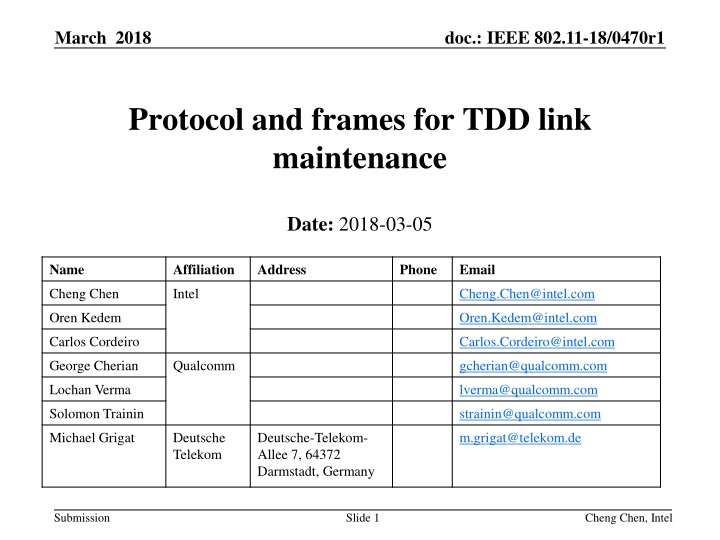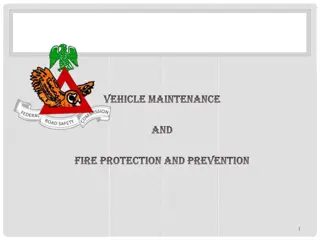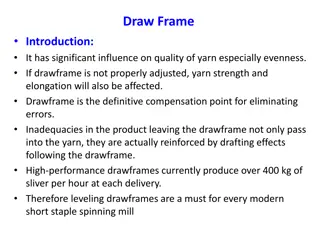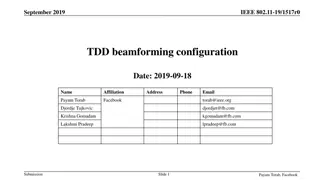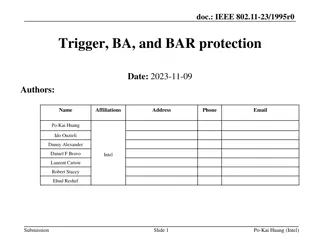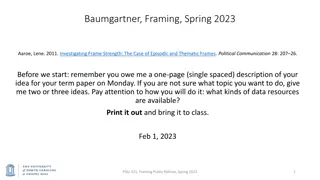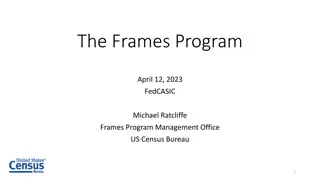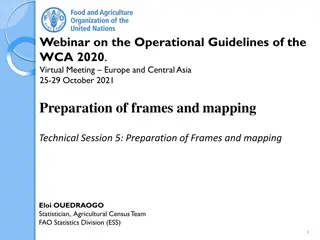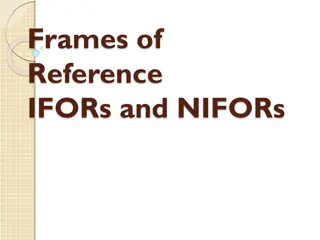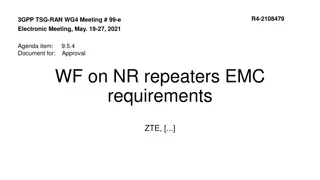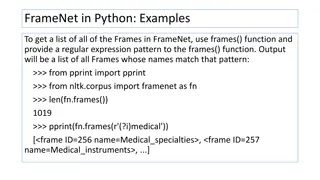Protocol and Frames for TDD Link Maintenance
Proposal for TDD link maintenance protocol and frames in IEEE 802.11-18/0470r1 document, focusing on mmWave distribution network management functions, including Heartbeat, Keep Alive, and Uplink Bandwidth Requests.
Download Presentation

Please find below an Image/Link to download the presentation.
The content on the website is provided AS IS for your information and personal use only. It may not be sold, licensed, or shared on other websites without obtaining consent from the author.If you encounter any issues during the download, it is possible that the publisher has removed the file from their server.
You are allowed to download the files provided on this website for personal or commercial use, subject to the condition that they are used lawfully. All files are the property of their respective owners.
The content on the website is provided AS IS for your information and personal use only. It may not be sold, licensed, or shared on other websites without obtaining consent from the author.
E N D
Presentation Transcript
March 2018 doc.: IEEE 802.11-18/0470r1 Protocol and frames for TDD link maintenance Date: 2018-03-05 Name Affiliation Address Phone Email Cheng Chen Intel Cheng.Chen@intel.com Oren Kedem Oren.Kedem@intel.com Carlos Cordeiro Carlos.Cordeiro@intel.com George Cherian Qualcomm gcherian@qualcomm.com Lochan Verma lverma@qualcomm.com Solomon Trainin strainin@qualcomm.com Michael Grigat Deutsche Telekom Deutsche-Telekom- Allee 7, 64372 Darmstadt, Germany m.grigat@telekom.de Submission Slide 1 Cheng Chen, Intel
March 2018 doc.: IEEE 802.11-18/0470r1 Abstract This contribution proposes the protocol and frames for TDD link maintenance. Submission Slide 2 Cheng Chen, Intel
March 2018 doc.: IEEE 802.11-18/0470r1 Motivation The mmWave distribution network usage model was recently approved to be one of the use cases for 11ay (11-17/1019r2) In order to support the operation of mmWave distribution network, several new management functions are needed (11- 18/0130r1) This contribution proposes a way to define and communicate several management functions for the new use case of mmWave distribution network. Goal is to build as much as possible on existing 11ad/ay spec, but introduce changes to accommodate new requirements. Submission Slide 3 Cheng Chen, Intel
March 2018 doc.: IEEE 802.11-18/0470r1 mmWave Distribution Network Management As defined in 11-18/0130r1, the management functions in mmWave Distribution Network that will be addressed in this proposal include: Heartbeat Keep Alive Uplink Bandwidth Request Submission Slide 4 Cheng Chen, Intel
March 2018 doc.: IEEE 802.11-18/0470r1 mmWave Distribution Network Management (0130r1) Management frames Direction Functions Heartbeat AP->STA only Update parameters and schedule Tx/Rx time slots for associated CNs. Keep Alive AP->STA only Indicate AP is alive and able to communicate, as well as negotiate Rx time slots with the peer STA UL BW Request STA->AP only Indicate the aggregate state of traffic and request for change of BW grant. Keep Alive AP STA (e.g., STA is collocated with another AP) UL BW Request Heartbeat STA Submission Slide 5 Cheng Chen, Intel
March 2018 doc.: IEEE 802.11-18/0470r1 Overall Proposal Reuse existing Announce frame and include specific information elements in Announce frame to act as the Keep Alive/Heartbeat/UL BW Request messages. Keep Alive and Heartbeat coalesced into a single IE Benefits of reusing Announce frame: Announce frame can be either Action or Action No Ack frame. The transmission of Announce frame can be either unicast or broadcast. Announce frame already includes the Timestamp field. TDD Slot Schedule element is already defined in [3] and included in Announce frame, which can be used for slot assignment/reservation for Keep Alive and Heartbeat messages. Other information elements can be included in Announce frame depending on the situation. Allows for minimal spec changes, minimizes overhead, and is efficient. Submission Slide 6 Cheng Chen, Intel
March 2018 doc.: IEEE 802.11-18/0470r1 Discussion Some of the functions in Keep Alive/Heartbeat/UL BW Request messages can be achieved using existing elements defined in 11ay, with possibly some minor modifications. Slot assignment in Heartbeat and slot reservation in Keep Alive can be achieved by reusing TDD Slot Schedule element, with an added slot type to be unavailable (see Slide 8) . Rate adaptation can be done by reusing DMG Link Margin element, with some new fields added (see Slide 9-11). DMG Link Margin IE will be included in Announce frame For slow feedback, it can be transmitted separately as Keep Alive/Heartbeat. For fast feedback, it can be aggregated with BlockAck frame. Define a new element for bandwidth request used in Keep Alive and UL BW Request messages (see Slide 12 and 13). Submission Slide 7 Cheng Chen, Intel
March 2018 doc.: IEEE 802.11-18/0470r1 Modification of TDD Slot Schedule element Slot assignment information carried in Keep Alive message is only used for bandwidth reservation, rather than bandwidth allocation Applicable for DN-DN scenarios see 0130r1 Therefore, we can add a new slot type in the TDD Slot Schedule element to indicate that this slot is unavailable. Propose to use the reserved value 11 (binary) in Bitmap and Access Type Schedule field within TDD Slot Schedule element to indicate the corresponding TDD slot is unavailable. Submission Slide 8 Cheng Chen, Intel
March 2018 doc.: IEEE 802.11-18/0470r1 Modification of DMG Link Margin element Extend DMG Link Margin element and enable it to optionally contain the information fields used for TDD rate adaptation. DMG Link Margin element format Fields Octets Element ID 1 Length 1 Activity 1 MCS 1 Link Margin 1 SNR 1 Reference Timestamp 4 Rate Adaptation Control 2 Contains the number of entries reported (NER) and indications of whether the element includes optional fields used for rate adaptation. Parameters Across PPDUs 0 or 3xNER Optionally present. If present, contains the subfields of parameters across PPDUs. Parameters Across LDPC Codewords 0 or 8*NER Optionally present. If present, contains the subfields of parameters across LDPC codewords. Parameters Across Blocks/Symbols 0 or 4*NER Optionally present. If present, contains the subfields of parameters across SC blocks or OFDM symbols. Submission Slide 9 Cheng Chen, Intel
March 2018 doc.: IEEE 802.11-18/0470r1 Modification of DMG Link Margin element Rate Adaptation Control field format Subfields Bits Note Number of Entries Reported (NER) 3 The value of this subfield plus one indicates the number of entries being reported. The entries are indexed (1 to 8) and represent space time streams. If the value of this field is greater than 1, the MCS, Link Margin and SNR fields are reserved. Indication for Parameters Across PPDUs 1 Set to 1 if the DMG Link Margin element contains the Parameters Across PPDUs field. Set to 0 otherwise. Indication for Parameters Across LDPC Codewords 1 Set to 1 if the DMG Link Margin element contains the Parameters Across LDPC Codewords field. Set to 0 otherwise. Indication for Parameters Across SC Blocks or OFDM Symbols 1 Set to 1 if the DMG Link Margin element contains the Parameters Across Blocks/Symbols field. Set to 0 otherwise. IsEDMG 1 EDMG (1) or non-EDMG (0). Used to differentiate MCS field. IsSC 1 SC (1) or OFDM (0). Used to differentiate MCS field. Reserved 8 Parameters Across PPDUs field format Parameters Across LDPC Codewords field format Parameters Across Blocks/Symbols field format Subfields Bits Subfields Bits Subfields Bits Average Iterations 8 RSSI 8 EVM 8 Max Iterations 8 SNR Per STS 8 Number of SC Blocks or OFDM Symbols 24 Nonzero Syndromes 24 Number of PPDUs 8 Number of LDPC Codewords 24 Submission Slide 10 Cheng Chen, Intel
March 2018 doc.: IEEE 802.11-18/0470r1 Modification of DMG Link Margin element Field Subfields Note Parameters Across PPDUs field RSSI RSSI for the RF chain, as defined in 30.2.2 SNR per STS SNR for the space time stream, as defined in Table 54 (D1.0) Number of PPDUs Number of PPDUs used to over which the RSSI and SNR measurement were taken Parameters Across LDPC Codewords field Average Iterations Average number of iterations used by the LDPC decoder for DPHY. One iteration includes processing of all rows. Value quantized to 0.1, range 0.0 to +25.5. Reset when Reset condition met. Max Iterations Maximum number of iterations used by the LDPC decoder for DPHY. One iteration includes processing of all rows. Value of integer, range 0 to +255. Reset when Reset condition met. Nonzero Syndromes Number of DPHY LDPC codewords with nonzero Syndrome. Reset when Reset condition met. Number of LDPC Codewords Number of DPHY LDPC codewords processed and included in the Average Iterations, Max Iterations and Nonzero Syndromes statistics. Reset when Reset condition met. Value 0 means not applicable. Parameters Across Blocks/Symbols field EVM Indicates the average EVM in dB of the SC data symbols or OFDM data subcarriers, averaged across all PPDUs and SC blocks or OFDM symbols, having same modulation and MCS. Value quantized to 0.2dB, range -5.0 to +46.0dB. Reset when Reset condition met. Count of the SC Blocks or OFDM Symbols included in the average EVM value. Value is saturated to 224-1 if overflows. Reset when Reset condition met. Value 0 means not applicable. Reset condition is defined as follows: Any change of: modulation (SC/OFDM), MCS, Constellation, LDPC mode, GI/CP mode, MIMO rank, MIMO type. End of reporting period Number of SC Blocks or OFDM Symbols Submission Slide 11 Cheng Chen, Intel
March 2018 doc.: IEEE 802.11-18/0470r1 TDD Bandwidth Request element A newly defined TDD Bandwidth Request element carries the information fields needed for bandwidth reservation request included in Keep Alive and UL BW Request messages depending on the situation. Announce frame Action field format Order Information Notes 23 TDD Bandwidth Request The TDD Bandwidth Request element is optionally present. If present, the TDD Bandwidth Request element carries the information needed for bandwidth reservation for TDD networks. Submission Slide 12 Cheng Chen, Intel
March 2018 doc.: IEEE 802.11-18/0470r1 TDD Bandwidth Request element TDD Bandwidth Request element format Subfields Bits Note Element ID 8 Length 8 Element ID Extension 8 Queue Params subfield format Subfields Bits Note Transmit MCS 8 Recommended MCS value for STA to AP transmission TID 5 For values from 0 to 15, indicates the TID corresponding to the queue. Value 31 indicates that this field is not applicable. Other values are reserved. Requested Tx Percentage 16 In unit of 0.01 percent Number of Queue Params 5 Defines the number, N, of subsequent Queue Params subfields. Reserved 3 Reserved 3 Queue Params 1 72 Queue Size 32 In units of bytes Traffic Arrival Rate 32 Arrival rate since the last reporting event. In units of 1 Kbps. Queue Params i 72 1 i N Submission Cheng Chen, Intel Slide 13
March 2018 doc.: IEEE 802.11-18/0470r1 Summary Set of changes proposed in this document include: Defining a new slot type in the existing TDD Slot Schedule element Modifying the existing DMG Link Margin element Defining a new element for link maintenance Defining capabilities to support each measurement type We believe these are the minimum set of changes required to fulfill the requirements specified in 11- 18/0130r1 Submission Slide 14 Cheng Chen, Intel
March 2018 doc.: IEEE 802.11-18/0470r1 Straw Poll Do you agree with the set of changes described in this presentation (Slides 6-13) to address TDD Link Maintenance? Yes No Abstain Submission Slide 15 Cheng Chen, Intel
March 2018 doc.: IEEE 802.11-18/0470r1 References [1] IEEE 802.11-17/1019r2 mmWave Mesh Network Usage Model [2] IEEE 802.11ay D1.0 [3] IEEE 802.11-17/1640r0 Draft text for Scheduling for mmWave Distribution Networks [4] IEEE 802.11-18/0130r1 Link Maintenance in Distribution Networks Submission Slide 16 Cheng Chen, Intel
